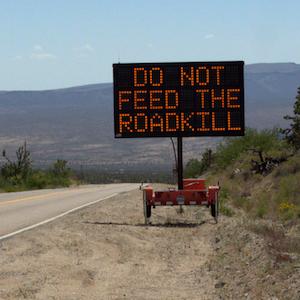"Ew, what was that?" is perhaps the most common refrain uttered by people as they drive past roadkill. Most people find these carcasses repulsive, as they glide their cars carefully around the bloody remains. But a team of microbiologists and chemists from the University of Oklahoma hope that roadkill will prove to be a biomedical gold mine.
Because of widespread antibiotic resistance and a dwindling pipeline for new drugs, scientists are in a global hunt for new antibiotics. A potential source is the microbiome of humans. The bacteria that live in and on our bodies are adept at keeping pathogens away. One reason is competition for resources, but another likely reason is that they produce molecules that are poisonous to unfriendly bacteria. Some strains of E. coli, for example, produce "colicins," toxins that kill other kinds of E. coli. Identifying molecules such as these could unlock the door to new types of antibiotics, and many researchers are pursuing this line of investigation.
But there are other, less traveled sources to look for bacteria in the world. Zoo animals are one idea, but the microbiome of captive animals is often different from their wild kin. Wild animals are inconvenient, not just because capturing them can be tricky but because of government regulations. So the researchers pondered where they could find a convenient source of wild animals that were largely free of government regulation. That's when they heard the call of Oklahoma State Highway 9.
With scientific collectors' permits in hand, the researchers sent hapless students to take samples from dead animals that they had noticed on the side of the road from the night before. "Our opportunistic sampling covered about 30 miles, which covers a transition from suburban (campus) to farmland and forest/prairie, offering ample misfortune for the resident wildlife," Dr. Bradley Stevenson told ACSH in an e-mail.
 The team swabbed the body orifices (e.g., mouth, eyes, ears, rectum) of any mammal unfortunate enough to have crossed paths with an automobile. They sampled armadillos, deer, opossums, raccoons, squirrels, and even skunks. Then, they isolated bacteria and grew them in the laboratory, after which they extracted chemicals that were produced by the bacteria. These chemicals were then assayed for their ability to kill or inhibit the growth of microbes. (A visual depiction of their methodology is on the right.)
The team swabbed the body orifices (e.g., mouth, eyes, ears, rectum) of any mammal unfortunate enough to have crossed paths with an automobile. They sampled armadillos, deer, opossums, raccoons, squirrels, and even skunks. Then, they isolated bacteria and grew them in the laboratory, after which they extracted chemicals that were produced by the bacteria. These chemicals were then assayed for their ability to kill or inhibit the growth of microbes. (A visual depiction of their methodology is on the right.)
Possum Possibilities
The most promising discovery came from the ear of an opossum. Two different bacteria located there, Pseudomonas and Serratia, produced compounds that inhibited the ability of yeast (Candida albicans) to form a biofilm. While the compounds did not kill the yeast cells, preventing yeast from forming a biofilm could be medically relevant. Biofilm formation is one mechanism by which pathogens establish long-lasting infections.
The authors then identified potential genes that could be involved in the synthesis of these compounds. If the molecules end up being medically useful, synthetic biology techniques could harness these genes to manufacture them in large quantities.
"At any number of dinner parties or receptions that I attend, by the time I tell someone that I am a microbiologist and that I don't golf, there isn't much left to talk about," Dr. Stevenson lamented. But, "After we started doing this research, however, I can often get boxed into a corner talking about roadkill and their drug-producing microbiomes."
Source: Jeremy L. Motley, Blake W. Stamps, Carter A. Mitchell, Alec T. Thompson, Jayson Cross, Jianlan You, Douglas R. Powell, Bradley S. Stevenson, and Robert H. Cichewicz. "Opportunistic Sampling of Roadkill as an Entry Point to Accessing Natural Products Assembled by Bacteria Associated with Non-anthropoidal Mammalian Microbiomes." J. Nat. Prod. 80(3): 598-608. Published: 21-Nov-2016. DOI: 10.1021/acs.jnatprod.6b00772




